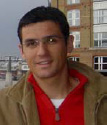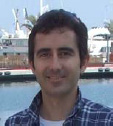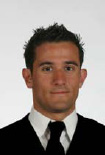|
|
|
| |
| ABSTRACT |
|
The purpose of this study was twofold: (a) to develop an underwater chronometer capable to provide feedback while the athlete is swimming, as well as being a control tool for the coach, and (b) to analyse its feedback effect on swim pace control compared with feedback provided by the coach and with no feedback, in 25 m and 50 m swimming pools. 30 male swimmers of national level volunteer to participate. Each swimmer swam 3 x 200 m at aerobic speed (AS) and 3 x 200 m just under the anaerobic threshold speed (AnS), each swam repetition with a different feedback condition: chronometer, coach and without feedback. Results (a) validate the chronometer system developed and (b) show that swimmers pace control is affected by the type of feedback provided, the swim speed elected and the size of the swimming pool. |
| Key words:
Underwater chronometer, self-regulation, performance, lap time.
|
Key
Points
- Providing concurrent feedback to swimmers improves theis swimming pace control.
- It is more important to provide feedback to control swim pace when the swimming pool is 50m long.
- Technological development as this chronometer system, could offload coach work, so coach can focus its time and attention on other performance aspects or other swimmers.
- Technological developments are more accepted by coaches when they don’t interfere on swimmers execution, that is, whet it is not necessary to implement the swimmer with cables and apparatus.
|
In recent decades scientific support to training has become a more and more indispensable element (Anderson et al., 2002; Gauthier, 1985; Guadagnoli, 2002; Pérez and Llana, 2005; Viitasalo, 2001). Instruments that can offer sport feedback -a key element in the process of learning (or improvement) in both technical and tactical terms (Schmidt and Young, 1991) - are a good example of this type of development. Therefore, the way, the amount and the frequency in which feedback is obtained can affect performance. The term feedback refers to performance-related information that the learner receives during and after performing the task, and there are two general types of feedback: a) Intrinsic feedback: characterised by the sportsperson receiving the information “in real time” through different sensory mechanisms (exteroception and proprioception) which allows him/her to self- regulate movement and/or adapt the execution of the motor task to the model image, b) Extrinsic feedback: name given to the artificial feedback that supplements intrinsic feedback, or increased feedback information (Swinnen, 1990). It refers to information from external sources such as the coach, a companion, a video or photographic camera, etc. It is considered to be supplementary to intrinsic feedback since the latter may be incomplete or mistaken, as the external source makes its analysis from a different perspective from that of the sportsperson. Extrinsic feedback is classified according to the following: a) the moment in which it is supplied; concurrent (while the sporting action is carried out), or terminal (after it is carried out) (Lai and Shea, 1999), b) according to the transmission channel: verbal or non-verbal (Hebert and Landin, 1994), and c) depending on the knowledge of the results and/or the performance (Schmidt and Lee, 1999). In a sporting discipline as swimming, the feedback that swimmers receive plays a key role in the improvement-consolidation of technical performance, in both the learning process (Salmoni et al., 1984) and the improving of the swimming technique (Bilodeau, 1966). The intrinsic feedback to the swimmer is always present, since it comes from the information that the nervous system receives through different receptors of the human body (Latash, 1998). However, the swimmer’s extrinsic feedback depends on “something” or “somebody” giving him/her information about his/her technical performance, since the swimmer’s “sensations” with respect to performance do not always coincide with the external evaluation. As well as informing swimmers about the results (e.g. swim time), extrinsic feedback also has other implicit functions, as pointed out by Newell, 1976, such as: a function as a guide to learning, an associative function, and lastly a motivating or incentive function. These functions do not exclude each other but can be present at the same time, thus increasing the probability that the following performance action may be taken in the right direction. Due to the environmental conditions that surround the swimmer (water, humidity, open space, etc.), there is limited or reduced use for electronic systems or instruments to give feedback. For this reason, the extrinsic feedback that the swimmer receives is mostly verbal or with gestures, generally supplied by the coach on the pool deck. Nevertheless, technological progress allows for instruments to be developed more and more to aid control during training, for example through systems that control the swimmer’s speed by means of pace-maker lights (González et al., 2002), dual-media images (Vezos et al., 2007), or speedometers (Seifert and Chollet, 2005). However, apart from the environmental problems that surround the swimmer, breakthroughs to date pose two problems in helping to control the swimmer’s training and/or information: a) the need to equip the swimmer with some system, such as a tube and/or special goggles (Aqua FM PRO system®), and b) the lack of tools to store the information from the swimming session, which is useful to plan the training (Pérez et al., 2005), despite the existence of useful tools such as goggles with a built-in chronometer (Clothier, 2005), which do not require the swimmer to be equipped with additional material that may interfere with swimming, but which are not useful for the coach to communicate or for storing information. Thus, the aims of this study were: a) to develop a timing system capable of informing without the need to equip the swimmer, able to store the registered information and to allow communication between the coach and the swimmer without halting performance, and b) to analyse the influence of coach feedback, chronometer feedback, or no feedback on aerobic swimming speed during the training session. Apparatus and taskTo analyse the effect of lap time feedback on swimming pace control, an underwater chronometer was developed (Pérez and Llana, 2006) made up of two clearly distinctive elements (see Figure 1): a) a piece of hardware that should allow the swimmer to see his/her times without any kind of implement or accessory that may hinder performance, and b) computer software capable of handling the necessary information such as the swimmer’s characteristics, distance covered, lap times, or previous training sessions. The chronometer’s hardware is divided into two parts: First of all, outside of the pool the central unit (2) and various accessories are controlled by a micro-controller that stores the information by sessions in a memory. The start/stop of the system is carried out with a keypad (3) connected to the central unit. This allows lap times to be sent to the underwater screen through an asynchronous serial transmission of the data obtained. Likewise, this data is also sent to a PC (6) by radio frequency, thanks to the use of two telemetric transducers. Finally, in the pool, the underwater led screen (6) together with a contact platform (4) adaptable to any pool ledge, handles the data received in the central unit such that at each turn, on putting pressure on the contact platform, the swimmer is shown the lap and total time as well as the number of laps covered. As for the Software (written in C language) and its working system, compatible with a Windows® environment (and created in Visual Basic), this allows the micro-controllers to perform previously designed sequential tasks, such as time control, showing digits on screen, etc. With respect to the power needed to use the chronometer, a power supply (1) of 12v and 10Ah, provides the necessary energy for the chronometer’s hardware. Also, a second power supply, belonging to the PC itself (7), provides the necessary current through the USB port to feed the radio frequency receiver (5). During chronometer system development, their accuracy and reliability was compared with a FINA official chronometer system (Omega Swin-O-Matic OSM 6). A perfect correlation between them was found (r = 1, p < 0.01).
Subjects and proceduresOnce the chronometer was developed and in order to analyse the effect of the external feedback provided by the device on swimming pace control, 30 male national level swimmers (age = 18.48 ± 1.08 years, height = 1.80 ± 0.04 m, body mass = 73.38 ± 2.34 kg) volunteer to participate. All swimmers were informed verbally and in writing about the nature of the study, including all potential risks. Written informed consent was obtained prior to participation and the ethics committee of the University of Valencia granted ethical approval. swimmers carried out the tests in two different length pools: 25m (short) and a 50m (long) swimming pool, using freestyle (“front crawl”) in all tests. The coach chose two aerobic swimming speeds for each swimmer individually: a) aerobic swim speed (AS), defined as the first increase of blood lactate above the resting level, and b) just under the anaerobic threshold swim speed (AnS), defined as the maximal lactate steady state. These individual speeds were determined by a lactate test based on a maximal 200 m front crawl swimming (4 x 200m) performed the week before (Anderson et al., 2008; Kapus et al., 2008; Pyne et al., 2001). Each swimmer covered 200 m at the two specified swimming speeds and with three different feedback conditions: a) Without feedback: the swimmer was informed about the swimming speed before starting to swim, and while swimming there is no kind of information given as to whether he/she is meeting this target speed, b) With traditional (coach) feedback: the swimmer was informed about the swimming speed before starting to swim, and after each two turns receives visual (body-language: to gesture with one’s hands) and sound (whistle or voice) feedback provided by the coach who is at the edge of the pool, and c) With feedback provided by the underwater chronometer: the swimmer was informed about the swimming speed before starting to swim and, after each two turns, looks at his/her lap times on the chronometer which is at the bottom of the pool. This was performed two times: in a 25m swimpool and in a 50m swimpool. At the end, each swimmer performed 1200 m so many in the 25m and 50m swimming pools: one repetition at the AS and other repetition at the AnS speeds in each of the 3 feedback conditions. Between each 200m swim, swimmers rested for 10 minutes to avoid possible fatigue in the following test.
Statistical analysisTo assess the influence of the variables on swim-time performance an ANOVA (Type III) design was used including the factors: pool length (levels: short and long), swim speed (levels: aerobic swim speed “AS” and anaerobic threshold swim speed “AnS”), and feedback (levels: chronometer, coach and none). The “subject” factor was included to analyze its interaction with the other factors. A significance level α .05 was fixed and a post hoc LSD Multiple Range Test was made to distinguish differences between levels of the factors.
Results show that swimmers pace control is affected by the type of feedback provided, the swim speed elected and the size of the swimming pool, as is showed in Table 1. Swim-time- depending on factor feedback (chronometer vs. coach vs. none feedback) showed statistically differences (p < 0.01) (Figure 2). However, multiple range test (LSD) exclusively detected differences between group of feedback coach-chronometer in relation to none feedback condition, while the interaction between “swimmer” and feedback condition was not significant (p > 0.05). In relation to the effect of feedback for different pool length (for both swim speeds), no significant differences (p = 0.24) could be found in short pool (25m). Nonetheless, the interaction with the factors feedback-swim speed showed significant differences (p = 0.014) (Figure 3A). In long pool (50m), the effect of feedback on Swim-time was significant (p < 0.01), although multiple range test (LSD) only detected differences between none feedback condition and the other conditions. The interaction between factors feedback-swim speed was not significant (p > 0.05) (Figure 3B). Relative to swim speed, significant differences were found for (“AS”) aerobic swim speed (p<.01) (figure 4A) and for (“AnS”) anaerobic threshold swim speed (p = 0.01). In both cases, multiple range test (LSD) detected differences between group coach/chronometer in relation to none feedback condition. In both swim speeds, the interaction between factors swimmer-feedback was not significant (AS with p = 0.99 and AnS with p = 0.99). The aim of the present study was twofold: to develop a system able to help swimmers and coaches during training session, and then, to analyse its feedback effect on aerobic swimming speeds comparing it with the coach feedback and without feedback. A new chronometer system telemetrically connected with a PC with specific software was developed and validated with respect a FINA official chronometer system (r = 1, p < 0.01). This new specific tool allows the coach to focus his/her time and attention on other aspects that affect performance or on other swimmers. In this way, coach can be sure that all times performed by swimmers will be stored and analyzed at a later stage. As many authors indicate (Chollet et al., 1988; Gonzalez et al., 2002; Pérez and Llana, 2006) until now, the possibility of supplying feedback in water sports has been hindered by communication difficulties between swimmer and coach posed by the aquatic and acoustic environment of the swimming pool. In this regard and meeting one of this study’s aims, the new chronometer system allows feedback to be given to the swimmer without interfere with swimming performance. Also, as Litle and Mc Cullagh, 1989 shown, it may be a motivational tool for augmented energize individuals by making the task seem more interesting. As for the kind of feedback given by the chronometer, this would be classify as extrinsic (Schmidt and Lee, 1999), intermittent (Lai and Shea, 1999), non-verbal (Hebert and Landin, 1994), and capable of informing about Knowledge of performance and results (Newell and Carlton, 1987; Schmidt and Young, 1991; Schmidt and Lee, 1999). Grosser and Neumaier, 1986 also remark that, as this kind of feedback operates with the athlete’s short term memory, this immediate feedback is more effective than retarded feedback, which operates with the -less reliable and accurate- medium or long-term memory. Moreover, the developed software allows coaches to transmit short instructions (text message) to the swimmer by means of a laptop computer, but this implementation had not been used on this study. The benefit of kinematic feedback may be optimised if its content specifies information that cannot otherwise be generated from other sources such as intrinsic sources (Schmidt and Young, 1991). In this sense, it has been suggested that intermittent augmented feedback is effective, as a guides the learner to correct response, minimizes errors, and maintains behaviour on target (Schmidt and Wulf, 1997; Schmidt and Lee, 1999). Once the underwater chronometer had been developed and some of the needs explained in the introduction with respect to swimming tools and materials had been solved, the aim of the study was to analyse the effect of the extrinsic feedback provided by this new tool on controlling the swimming pace during training. In this respect, and being sure that the tests were carried out at two statistically different swimming speeds (p < 0.01), the results showed that chronometer and coach feedback has similar effects on swimming pace control in both sort (25 m) and long (50 m) swimming pool (figure 2). So provide intermittent and immediate feedback has a positive influence on the swimmer’s ability to keep up the swim speed. Also, no interaction between swimmer and feedback factors suggests that this effect is similar for all analysed swimmers. Respect the effect of swimming pool length (Figure 3), only the swim-time in long pool (50 m) was significant different depending on feedback condition (coach/chronometer), with more variance in none feedback condition. As in short pool, only the interaction on swim-time at anaerobic threshold swim speed (“AnS”) and none feedback condition was significant difference respect other feedback conditions (coach/chronometer), with lees variance in chronometer feedback respect coach feedback. Finally, swim-time at the two swim speed selected (As / Ans) were significantly different depending on the type of feedback (Figure 4). However, differences between coach and chronometer feedback condition at anaerobic threshold swim speed were not greater than aerobic swim speed, where swim-time using chronometer feedback showed lees time and lees variance. In this sense, a number of studies have found that the performance and learning of a skill, such as cycling (Broker et al., 1993), or as at this case, in swimming (Chollet, et al., 1988), is enhanced when feedback is provide. These studies indicate that augmented feedback in real time can have powerful effect on performance in certain sport tasks: swimming pace control must be added to these tasks. In future studies we must known (a) if this chronometer system can improve the two types of feedback used in the context of motor learning: Knowledge of results and Knowledge of performance (Newell and Carlton, 1987; Schmidt and Young, 1991), due to the software possibility to transmit short instructions (text message) to the swimmer by means of a laptop computer, and (b) its possible effect as motivational or incentive tool as indicated by Newell, 1976. The present study has validated a new chronometer system that provides intermittent real time feedback to swimmers without interfering swimmer execution. Results showed that swimmers pace control is affected by the type of feedback provided, the swim speed elected and the size of the swimming pool. In future studies the new chronometer system can be a very useful tool to evaluate other aspects on feedback effect on swimming performance such as motor learning and psychological effect, not only in freestyle but in breaststroke and in butterfly. |
| AUTHOR BIOGRAPHY |
|
 |
Pedro Pérez |
| Employment: Assistant Doctor on Department of Sport and Physical Education, University of Valencia, Spain |
| Degree: PhD |
| Research interests: Swimming biomechanics. Gait plantar pressure. |
| E-mail: pedro.perez-soriano@uv.es |
| |
 |
Salvador Llana |
| Employment: Lecturer on the Department of Sport and Physical Education, University of Valencia, Spain |
| Degree: PhD |
| Research interests: Swimming biomechanics. |
| E-mail: salvador.llana@uv.es |
| |
 |
Gabriel Brizuela |
| Employment: Professor on Department of Sport and Physical Education, University of Valencia, Spain |
| Degree: PhD |
| Research interests: Sports Biomechanics. Footwear and adapted physical activity |
| E-mail: Gabriel.Brizuela@uv.es |
| |
 |
Alberto Encarnación |
| Employment: Scholarship research of Department of Sport and Physical Education, University of Valencia, Spain |
| Degree: Bachelor of Physical Education |
| Research interests: Swimming biomechanics and gait analysis. |
| E-mail: alberto.encarnacion@ibv.upv.es |
| |
|
| |
| REFERENCES |
 Anderson M., Hopkins W., Roberts A., Pyne D. (2008) Journal of Sports Science. |
 Anderson R., Harrison A.J., Lyons G., Ujihashi V., Haake S.J. (2002) The engineering of sport 4. |
 Bilodeau I. M., Bilodeau E. A. (1966) Adquisition of skill 55.. |
 Broker J.P., Gregor R.J., Schmidt R. A. (1993) Extrinsic feedback and the learning of kinetic patterns in cycling. Journal of Applied Biomechanics 99, 111-123. |
 Chollet D., Micallef J.P., Rabischong P., Ungerechts B.E., Wilke K., Reishle K. (1988) Swimming Science V. |
 Clothier J. (2005) Smart goggles easy on the eyes. |
 Gauthier G.M. (1985) Visually and acoustically augmented performance feedback as an aid in motor control learning: a study of selected components of the rowing action. Journal of Sports Sciences 33, 3-26. |
 Gonzalez V., Sanchis E., Villalobos M., Brizuela G., Llana S., Tella V., Chatard J.C. (2002) Biomechanics and Medicine in Swimming IX. |
 Grosser M., Neumaier A. (1986) Técnicas de entrenamiento: teoría y práctica de los deportes. |
 Guadagnoli M., Holcomb W., Davis M. (2002) Journal of Sports Science. |
 Hebert E.P., Landin D. (1994) Effects of a learning model and augmented feedback on tennis skill acquisition. Research Quarterly for Exercise and Sport 665, 250-257. |
 Kapus J., K. Anton, U. Boro, S. Venceslav K. (2008) Can blood gas and acid-base parameters at maximal 200 meters front crawl swimming be different between former competitive and recreational swimmers?. Journal of Sports Science and Medicine 77, 106-113. |
 Lai Q., Shea C.H. (1999) Research Quarterly for Exercise and Sport. |
 Latash M. (1998) Neurophysiological Basis of Movement. |
 Litle W.S., Mc Cullagh P. (1989) Motivation orientation and modelled strategies: The effects on form and accuracy. Journal of Sport and Exercise Psychology 111, 41-53. |
 Newell K.M., Carlton M.J. (1987) Augmented information and the acquisition of isometric tasks. Journal of Motor Behaviour 119, 4-12. |
 Newell K.M., Keogh J, Hutton R.S. (1976) Exercise and Sports Sciences Reviews. |
 Pérez P., Llana S. (2006) Race pace control by means of a new chronometer system. Biomechanics and medicine in swimming X. Portuguese Journal of Sport Sciences 66, 81-82. |
 Pérez P., Llana S., Zahonero J., Navarro P., Hellard P., Sidney M., Fauquet C., Lehénaff D. (2005) Proceedings First International Symposium on Swimming. |
 Pyne D.B., Lee H., Swanwick K.M. (2001) Medicine & Science in Sports & Exercise. |
 Salmoni A.W., Schmidt R.A., Walter Ch.B. (1984) Knowledge of results and motor learning: a review and Critical reappraisal. Psychological Bulletin 995, 355-386. |
 Schmidt R.A., Lee T.D. (1999) Motor control and learning: a behavioural emphasis. |
 Schmidt R.A., Wulf G. (1997) Continuous concurrent feedback degrades skill learning: Implications for training and simulation. Human Factors 339, 509-525. |
 Schmidt R.A., Young D.E. (1991) Methodology for motor learning: a paradigm for kinematic feedback. Journal of motor behaviour 223, 13-24. |
 Seifert L., Chollet D. (2005) A new index of flat breaststroke propulsion: A comparison of elite men and women. Journal of Sports Sciences 23, 309-320. |
 Swinnen S.P. (1990) Interpolated activities during the knowledge of results delay and post-Knowledge of results interval: effects on performance and learning. Journal of Experimental Psychology: Learning, Memory and Cognition 116, 692-705. |
 Vezos N., Gourgoulis V., Aggeloussis N., Kasimatis P., Christoforidis C., Mavromatis G. (2007) Underwater stroke kinematics during breathing and breath-holding front crawl swimming. Journal of Sports Science and Medicine 6, 58-62. |
 Viitasalo J.T., Era P., Konttinen N., Mononen H., Mononen K., Norvapalo K. (2001) Scandinavian Journal of Medicine & Science in Sports. |
|
| |
|
|
|
|

